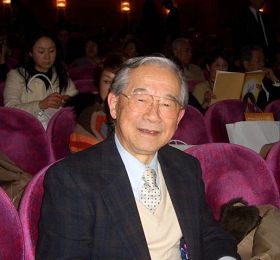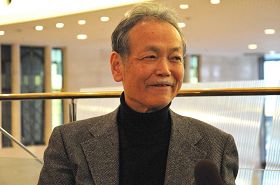(Clearwisdom.net) Having graced Japan twice in the past two years, the Divine Performing Arts (DPA) once again made a sensation in Japan with its extravaganza of classic Chinese dance and music. Mr. Shigihara, a professor and well-known theater and music critic, and Mr. Akiya Nakahara, a famed Japanese music critic, composer, and music educator, attended the DPA show at Umeda Arts Theater in Osaka on February 18, 2009.
Professor Shigihara, a well-known theater and music critic from a Japanese University at DPA show in Osaka

Akiya Nakahara, a famed Japanese music critic, composer and former professor from Kyoto Women's University
Mr. Shigihara enjoyed the show, finding it a "unique and profound"
experience.
"This theme is conveyed very clearly. The show revitalizes the Tang Dynasty
as an ideal period in history. The visual effect was very powerful, and the
dances were also extremely clear," he said. Story-based dance is one of the
DPA trademarks. Such dances explore a range of themes from both the ancient and
modern worlds.
He explained that the most popular shows in Japan are very people-friendly, and
DPA possesses that standard. "Its methods are very good. With the latest
and prominent reviews, the show carries the characteristic of the arts for the
general public. It is a show that can bring joy to everyone.
"Although I've watched other shows that demonstrate Chinese traditions,
it is my first time seeing this kind of stage art with its new approach to
reviving old traditions. It is retro, yet creative. From the allocation of roles
to the dancers [to the orchestration and scenery], the show itself contains many
characteristics of modern times."
As a researcher of Western dance medium, Mr. Shigihara said, "Every dancer's
own technique level is already superb. The entire choreography is unique. There
are many different combinations of dancers, and in each combination the dancers
displayed a variety of techniques. The choreography brings rhythm and is a feast
for the eyes."
As a music critic, he said DPA, "...unfolded Chinese traditional music
using modern orchestral instruments and Chinese folk instruments. This musical
adaptation is extremely amazing and can be heard throughout the whole show. The
arrangement of music is wonderful. Nobody will find disharmony anywhere in the
music. The music is enjoyable for the general public, although it's not
popular music."
"For Asian people, the tunes are catchy, and the use of folk instruments
makes the rhythms really steady and calming. I think it is a great achievement
for them to do this so well."
The costumes, like other elements of the show, delighted him. "The color designs are very successful. The colors express typical Chinese characteristics, such as humbleness and honesty. They are quite suitable for oriental mindsets, creating a resonance for Asian people. The stage costumes of DPA are gorgeous and colorful, yet they are not profligate, excessive, or arrogant. They perfectly synchronize with conventional Oriental feelings."
Mr. Nakahara said that he enjoyed the show very much and commented that the show conveys the "divinity" of Chinese traditional culture, and passes China's five-millennia-old history to the modern people.
"The Chinese traditional culture that began with Yellow Emperor went through such a long period to be passed down. [Chinese traditional culture] is particularly touching and meaningful in the current era.
"The music simply and clearly served to display the essence of Chinese classical dance," he said.
Referring to specific performances in the show, he said, "The elements
of Tibetan music and dance are conveyed very strongly. The same for 'Dance
of the Yi.' The music played a tremendous role in presenting the dance.
"The tenor and soprano were very amazing. With such power, even if there
was not a microphone, the sound was very mellifluous and moving. Also these
young female dancers have light and vivacious gestures. Their movements together
are so neat and uniform. I am shocked.
"This kind of stage production is new to me. For example, in the Tibetan
dance 'Dance of the Snow-Capped Mountain,' the backdrops displayed the
Himalayas. It really brought the audience into the ambiance of Tibet."
Mr. Nakahara, who was a professor at Kyoto Women's University, said that he
would love to watch the DPA performance again if he gets a chance, because the
show makes him feel "very joyous" in his heart.






